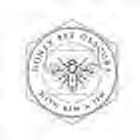I have been wearing the same underwear for 25 years. And the only thing weird about that is how well they have held up. In the late 1990s, my dear sister sewed each of her brothers a pair of blue polypropylene long underwear as gifts. These were much appreciated and much worn. To my amazement, after thousands of uses (and yes, quite a few washes), my pair persists and is still in the winter rotation, alongside more recent commercial versions. Why?? They seem to be made of the same stuff and my sister, while talented in other ways, is not known as a world-class seamstress. I chalk it up to resilience in fabric and (more likely) dense stitching. Some honey bees and their colonies share this resilience and a lot of effort and money is directed at finding out why.
Honey bee colonies are fundamentally resilient compared to other insects in several ways. First, colonies can withstand losses of thousands of worker bees and still recover. As one extreme, they routinely cut themselves in half and both halves survive. Additionally, they can reconstitute their most vital reproductive organ, the queen, from a single egg she has left behind. Colonies also survive a wide range of temperatures and humidities, in part because they regulate both of these in their living quarters. Arguably, they tolerate a greater range of climate and temperature zones (from Maine to Miami and beyond) than all animals besides humans. Honey bee colonies also seem to make things work whether they are in a continual brood cycle, as are many commercially managed bees, or subject to short active seasons and long winters, as found toward the poles. While there is evidence for genetic bee lineages that do best in particular climates, the fact is that most honey bees will survive at any place in their worldwide range.
Still, if honey bees are so resilient why is so much effort needed to keep them alive? And why do they fail us so often? Bees and beekeepers regularly face three major challenges: a wide range of biological threats (parasites and pathogens, mainly, with cameos from bears and badgers), a food landscape that lets them down, and exposure to damaging chemicals. Professor Tjeerd Blacquière, from Wageningen University in the Netherlands, a leading agricultural university, has spent decades trying to understand honey bee resilience and working with beekeepers to improve the genetic traits that lead to resilience. The data from this research, and the improvements seen, show how sustained scientific effort leads to practical improvements for beekeepers. Blacquière and Delphine Panziera have summarized their thinking in an openly available article from Bee World, “A Plea for Use of Honey Bees’ Natural Resilience in Beekeeping” (2018, volume 95:2, 34-38, DOI: 10.1080/0005772X.2018.1430999). They highlight several factors in the search for resilience, including both management and breeding ideals. The authors favor longterm ‘survival’ or ‘black box’ selection, whereby colonies are subjected to known stresses and then culled by the forces of selection, over the ‘trait-based’ selection found to be successful in many breeding programs. In trait-based selection, a key indicator of fitness is used to push populations; things like mite levels, hygienic behavior, or genetic markers for desired traits. Black-box selection, on the other hand, finds and exploits numerous genetic variants found in any population by subtly pushing the good combinations to higher frequency through stresses. The measures of success are as fundamental as colony survivorship, colony mass or reproduction by splitting. Both strategies can work and both have fan clubs. Perhaps the greatest challenge to natural selection approaches comes not in finding colonies or apiaries that do well, but in maintaining those traits for the long term, i.e., when selection is relaxed or the genetics of these colonies are diluted. Natural selection can favor expensive responses that serve a purpose for a certain time but are less useful later and hence are swiftly lost.
Trait-based selection suffers from the whack-a-mole liability. One can focus intensely on a single trait against a single threat and fail to protect against the next one and the next thereafter. Still, trait-based selection regimes used by breeders and scientists are often sophisticated and additive (e.g., bees that show hygienic behavior towards mites can be selected simultaneously for other behaviors such brood rearing patterns, or even non-behaviors such as individual immunity). As a geneticist, trait-based selection is more in my comfort zone, but it is fascinating to read the successes of Professor Blacquière and his ‘black box selection’ colleagues.
In some ways, the trait-selecters and the holistic crowd aren’t far apart at all. As Panziera and Blacquière found, one of the predominant traits of resilient bees is Varroa sensitive hygiene (VSH), a trait high on the list of trait-selecters (Panziera, D., van Langevelde, F., & Blacquière, T. (2017) Varroa sensitive hygiene contributes to naturally selected varroa resistance in honey bees. Journal of Apicultural Research, 56, 635–642, https://doi.org/10.1080/00218839.2017.1351860). Interestingly, though, a second resilient population from this same study showed VSH levels identical to controls, supporting their hypothesis that selection can run with multiple traits that are effective against strong threats. With Swiss colleagues and led by Arrigio Moro, Blacquière and Panziera recently scored multiple populations that had been under survival-based selection in the face of mite pressure. Again, VSH was important some of the time. Interestingly, the mites themselves also seem to have changed in the surviving stock. Clever cross-fostering experiments of mites from the two lineages suggest that mites in surviving populations become less impactful on their obligatory bee hosts after only a few years. (Moro, A.; Blacquière, T., Panziera, D., Dietemann, V., Neumann, P. Host-Parasite Co-Evolution in Real-Time: Changes in Honey Bee Resistance Mechanisms and Mite Reproductive Strategies. Insects 2021, 12, 120. https:// doi.org/10.3390/insects12020120).
So, this sounds interesting but what are the ground-rules for establishing more resilient populations. Blacquière and Panziera review several key points in establishing and propagating from resilient populations in their paper “Naturally selected Varroa resilient bees as re-wilding resource” (Natural Bee Husbandry, vol. 15, 28-31, https://www.researchgate.net/publication/341494593).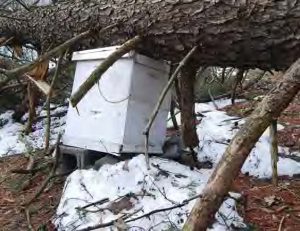 First, start big, with 25-30 colonies or more. Keep this selected population away from other gene pools. Even more challenging, withhold all human controls for Varroa mites. Minimize other stresses such as food stress and, presumably, chemical stress. And don’t expect results for four years or more. They also give guidelines for maintaining right-sized colonies and for housing and assisting swarms from successfully fit colonies. If you have the means, patience, and constitution to do this, report back in 25 years. I will be working on my second pair of underwear by then.
First, start big, with 25-30 colonies or more. Keep this selected population away from other gene pools. Even more challenging, withhold all human controls for Varroa mites. Minimize other stresses such as food stress and, presumably, chemical stress. And don’t expect results for four years or more. They also give guidelines for maintaining right-sized colonies and for housing and assisting swarms from successfully fit colonies. If you have the means, patience, and constitution to do this, report back in 25 years. I will be working on my second pair of underwear by then.
Finally, while we should all aim to use disease controls only when absolutely essential, please do not use this method if you cannot maintain distance from neighbors who are not on board. Your failing colonies will deliver mites to them, and their middling genes will hurt your chances of developing a special group of survivors.
]]>By: Becky Masterman and Bridget Mendel
On a recent trip to an apiary, we encountered a neighboring homeowner outfitted in a backpack sprayer, carefully spraying dandelions towards the ever elusive goal of a flawless emerald-colored lawn. Nothing against emeralds, but this deeply ingrained lawn aesthetic poses a few problems for bees. Flowerlessness means foodlessness for pollinators, but more dangerous still is the battle between man and dandelion, often fought with pesticides.
And dandelions will assert their will to power.
Back to our friendly homeowner who was working hard against his golden foes. When we inquired about what he was spraying, explaining that we kept honey bees nearby, he was immediately concerned. In fact, he had a large prairie planted in one section of his yard that supported the local wingeds. He asked us about bee-safe alternatives for maintaining his turf.
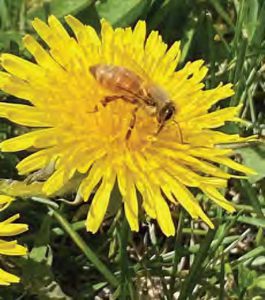
Spraying dandelion blooms directly with herbicides can result in bees bringing these chemicals back to their hives. Photo by Bridget Mendel
While at first this might read as a weird contradiction, it’s actually pretty common. There are lots of reasons to want to maintain a lawn beyond aesthetics, including picnics, kids, ball games, a dislike of ticks and chiggers, golf, city ordinances, etc. And it’s human nature to both try (the prairie) and fail (spraying dandelions) all in one day. Just today, one of us filled her reusable shopping bag (great job!) with avocados flown in from the other side of the world (sorry).
The word pesticide is often misused interchangeably with the word insecticide. The simple definition of pesticide is a chemical used to kill a pest. Insecticides, fungicides, herbicides (our homeowner’s weapon against dandelions) and miticides are all considered pesticides. How people use pesticides impacts our bees, but at the same time, as beekeepers we are acutely aware of the difficulty of managing tenacious pests. Many of us use pesticides in our colonies to fight varroa mites, so we can easily sympathize with the difficulty of pest control (pest, from the Latin pestis, “…a deadly disease, a curse or bane.”)
Some people make good cases for the use of pesticides, like farmers who use them to keep their crops from being absolutely destroyed. Do we hope the world moves away from agrochemicals? Absolutely. But it’s a complicated conversation that needs to be had before it can be resolved completely in the bees’ favor. Beekeepers should be talking to farmers, finding ways to connect, sharing resources about pollinator planting programs, and learning about farmers’ concerns. You might be surprised at how much they are already doing to support bees (please read our article about our friend Farmer Keith). If your bees are close to farmland, you can also register their location at https://beecheck.org/, though this step isn’t in lieu of real live farmer-beekeeper conversations.
Mosquito Control is another profession famous for their pesticide use, and honestly we’re grateful to them. Even controlled, mosquitos can truly ruin a summer’s evening, and we’re personally glad that we get to worry more about wasps sampling our picnic fare than about West Nile virus and encephalitis putting a sad twist on our picnicking lifestyle. But mosquito control can absolutely negatively impact bee health depending on the type and location of the pesticide use. Reach out to your local mosquito control district for information about how they protect pollinators.
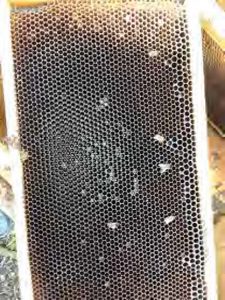
The dark cells in the brood nest area of this frame are filled with pollen that was entombed in propolis by the bees. It is an indication that the pollen is contaminated with a fungicide. Photo by Becky Masterman
Back to our friendly lawn lover. He was technically applying the herbicide correctly; the label does not direct the user to avoid spraying the flowers. We did share that bees visiting the treated flowers would bring the herbicide back to their home. But our very best suggestion was to give up entirely on the idea of the monoculture lawn and embrace the possibility of a “bee lawn” (https://www.beelab.umn.edu/learn-more/beelawn). Our colleagues at the Bee Lab thought long and hard about the whys and wherefores of lawns, in order to create an easy-to-maintain and bee-friendly alternative that still gave you that crisp, buzz cut look. When approaching neighbors, be generous with information about better, bee friendly turf (Bee Lawns). Many simply haven’t considered how their lawn care might be affecting pollinators, and will be happy to chat. For inspiration on cutting back on cosmetic pesticides, check out this link for information on Ontario’s long-time lawn and garden pesticide regulations (https://www.ontario.ca/page/pesticides-home-lawns-and-gardens).
Our visit with the ‘open to suggestions’ homeowner made it clear that if we are going to point out bee unfriendly practices, we should have some bee friendly alternatives ready to share. Otherwise, we’re just being judgmental. Like the researchers who developed the bee lawns, it’s important to ask why people are using pesticides in the first place. It’s unlikely to be an idle hobby, and while we personally go to weird lengths to help bees (one day we’ll write about Becky’s “bee bridge” project), we recognize that most people have human-centric priorities, and we totally respect that. Our goal is to help people find alternatives to pesticides whenever possible. The world can’t be perfect, but it can be more-so.
Minding Your Bees and Beeswax
Beekeepers should know the signs of pesticides impacting their bees and the safety of their hive products. Here is an excellent article from Purdue Extension with this information: https://extension.entm.purdue.edu/publications/E-53/E-53.html
Pesticides in wax, pollen and nectar are ubiquitous and a potential danger to both developing and adult bees (Zioga et al. 2020, Wilmart et al. 2021). Except for entombed pollen (see photo) which is often a fungicide contaminated pollen that the bees entomb with propolis (vanEnglesdorp et al. 2009), it is difficult to determine what chemicals might be in your hive without expensive testing. Rotating out brood combs every three to five years is a management strategy that addresses wax contamination issues.
References
Becky Masterman, Farmer Keith, Medina: A.I. Root Company, Bee Culture, Vol. 148 (5). P. 55-57 (2020).
Olivier Wilmart, Anne Legrève, Marie-Louise Scippo, Wim Reybroeck, Bruno Urbain, Dirk C. de Graaf, Pieter Spanoghe, Philippe Delahaut, Claude Saegerman, Honey bee exposure scenarios to selected residues through contaminated beeswax, Science of The Total Environment, Volume 772, (2021). https://doi.org/10.1016/j.scitotenv.2021.145533. (https://www.sciencedirect.com/science/article/pii/S004896972100601X)
Elena Zioga, Ruth Kelly, Blánaid White, Jane C. Stout, Plant protection product residues in plant pollen and nectar: A review of current knowledge, Environmental Research, Volume 189, (2020). https://doi.org/10.1016/j.envres.2020.109873. (https://www.sciencedirect.com/science/article/pii/S0013935120307684)
vanEngelsdorp, Dennis, Evans, Jay D, Donovall, Leo, Mullin, Chris, Frazier, Maryann, Frazier, James, Tarpy, David R, Hayes, Jerry, Pettis, Jeffery S. “Entombed Pollen”: A new condition in honey bee colonies associated with increased risk of colony mortality. SAN DIEGO: Elsevier Inc
Journal of invertebrate pathologyVol.101 (2), p.147-149 (2009)
Acknowledgement
The authors would like to thank Dr. Marla Spivak for helpful edits and suggestions.
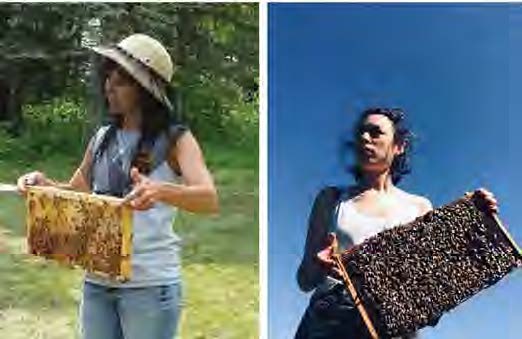
Authors Becky Masterman led the UMN Bee Squad from 2013-2019 and currently alternates between acting as an advisor and worker bee for the program. Bridget Mendel joined the Bee Squad in 2013 and has led the program since 2020. Photos of Becky (left) and Bridget (right) looking for their lost hives.
A cold, steady rain is coming down:
It’s May 9th in Northeast Ohio. Maple blooms – long gone. This season’s fruit bloom has come and gone. My bees are currently in a dearth. They are awaiting the next phase of the annual nectar/pollen flow that will come in a few days from sources like tulip poplar and clover. If the weather breaks, my bees will try to stay busy with some residual meager blooms and maybe rob their neighbors’ resources a bit. Until then, if you’re a bee forager, there’s not much to be done just now. Stand by. At this very moment, a cold rain is falling. It’s cold enough that frozen slush is accumulating on my truck windshield above the windshield wipers. I have packages and queens partially installed. The bees are out, but I still have the queens confined. I’m worried. It’s that worrying time of the year. Erratic Spring weather is typically worrying weather.
Worrying is a component of beekeeping:
Oh, so often, beekeepers are sold a bill-of-goods in beekeeping. Practicing the craft is “relaxing” and “rewarding”. We are told that it’s fulfilling. I should envision blue skies, gentle bees – with absolutely no inclination to swarm – flying contentedly to rewarding floral sources from which they will gather nectar to make delectable honey crops. In carefree fashion, I will extract this crop – without regard to 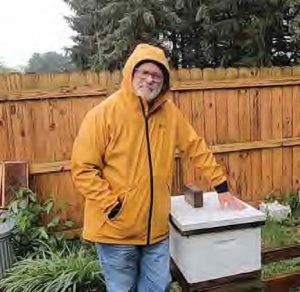 messiness and stickiness – and bottle it in attractive containers. Without even more regard to income, expense, or labor, I will then give my honey to deserving individuals, who will say, “Oh…you’re a beekeeper!?” I will humbly drop my head and reply, “Yes, I am a beekeeping practitioner of this noble craft.” Nowhere in my idyllic story did I mention expensive bee packages with confined queens on minimal honey stores in bee boxes that are sitting out in freezing rain.
messiness and stickiness – and bottle it in attractive containers. Without even more regard to income, expense, or labor, I will then give my honey to deserving individuals, who will say, “Oh…you’re a beekeeper!?” I will humbly drop my head and reply, “Yes, I am a beekeeping practitioner of this noble craft.” Nowhere in my idyllic story did I mention expensive bee packages with confined queens on minimal honey stores in bee boxes that are sitting out in freezing rain.
My beekeeping appreciation is not diminished:
I am not complaining about beekeeping. All those years ago, if I was sold a bill-of-goods, it was because I wanted to make the purchase. In oh-so-many ways, worrying puts a value on the decisions I make in my beekeeping enterprise. If this was an easy process – if we won every time – everyone would be beekeepers. So, when I do something right, it makes the decision-making event sweet and rewarding. But writing that statement does not mean that I am not concerned about the future of these packages that are back there right now – in freezing rain. I’m worried about them. Absolutely.
My worry last year:
I hope you don’t recall this memory, but exactly this time last season, I was worrying about my packages – just exactly as I am now. At that time, I wrote about it. But last season my worry was whether or not I could/should feed old honey from my Winter dead-outs back to my packages. I had a goodly amount of sullied honey that I did not feel was fit for my consumption, but I wondered if the bees might want it. Yes, they did. I wrote about the success of those packages building up on that old, dark honey. The packages grew into behemoth colonies. They became too tall. They were difficult to treat for mites. I never saw the queen, but thankfully I had little reason to search for her. The hives were crazy heavy. When I worked them, bees matted and festooned everywhere. Heavy smoke was always required. They were not enjoyable to work. I stopped worrying about old honey and shifted to worrying about managing large colonies. I worried about swarms departing from these mutants. I worried that these big bee boxes would disconcert my neighbors. I worried. I worried, but honestly, what beautiful challenges those beehives were. Last Winter came and went. It was nothing exceptional, but it was a typical Winter dearth. My beautiful colonies experienced the typical Winter colony die-off. I worried and I wondered if I would have any survivors. From my perspective, in my apiary, at this time in my life, I could not say that these oversized colonies succeeded any better than a typical two-deep colony. I am not suggesting anything about your situation. Could I write that sometimes big colonies can lead to big disappointments?
My personal take from that experience:
My personal take from that experience, and my take alone, was that (1) yes, within reason, I could feed ugly, old honey, in combs, to package bees. The bees did a beautiful job of refurbishing that honey and making new bees from it. I was judicious. I only put three of four frames of needy honey in the hive at one time. I tried not to overwhelm the three-pounds of bees doing the restoration work. My second observation (2), for me, was that huge colonies (3 deeps and two or three supers) did not fare any better that typical colonies. I’m not going to do that huge colony thing this season. I would rather have a few smaller colonies that I can manage more efficiently.
At this point, it is important for me to say that I am not the youthful beekeeper I once was. Smaller, more manageable colonies fit me better now. Years ago, I would have been much more in love with these larger units – but that’s just me.
A dead package queen:
Last season, one of my package queens was dead in the cage. The fairness of whether or not to replace such a queen is the stuff of another article topic. In my case, due to the distance to the provider and the policy of the provider, she would not be replaced. That may or may not be fair, but again we can discuss this some other time. The fact was that I had to deal with a queenless package. I simply combined the queenless package with a queenright package. As you would expect that double-package colony exploded. Later in the season, when I could get a queen, I divided the big colony into halves, and all ended (mostly) happily.
Now, too many queens:
Please hang in there – I’m going somewhere with this queen thread. This year, with the memory of last year still fresh, I picked up two extra queens. “I can always use them,” I said to myself. When I said that to myself, I had that idyllic view in mind that I discussed above. I did not picture long periods of rain and late season cold weather. I should have. Something like this happens every season. Now nearly 10 days later, I still have those queens in cages. I’m storing them in one of the package colonies. Of course, I worry about them.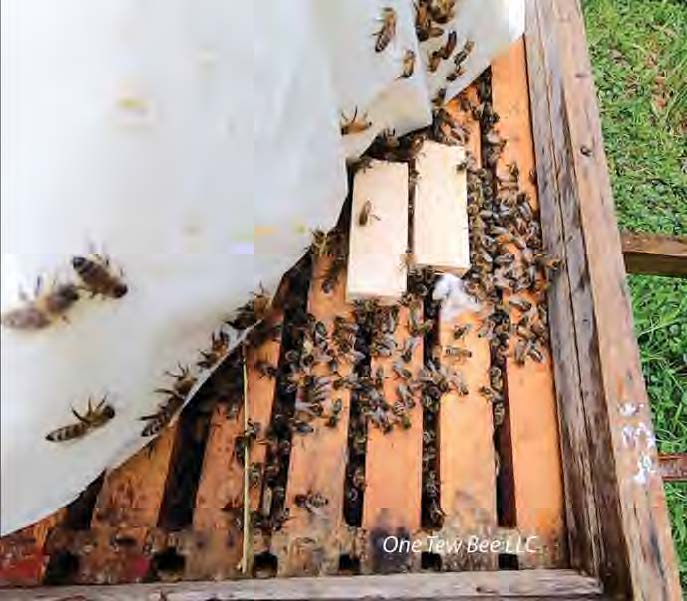 Years ago, when I raised my own queens and they were plentiful and cheap, I kept several queens in cages for nearly six weeks. Occasionally, I changed out the workers and fed fresh sugar candy along with an occasional drop of water. Though I knew the queens would not go forever, when they died, I was bummed. So, I know queens can be caged for long periods, but it can’t be good for them. That dead package queen has made me see that – for me – buying extra queens for early season use is not a great idea. If the early Spring weather is uncooperative, extra queens are hard to get into splits. If I have package queen issues, it seems to work best for me to combine the queenless packages, build that colony up, and then split it a few weeks from now when the season is dependable, and queens are a bit more readily available. What makes this work, for me, as well as it does, is that I still have abundant stores of comb honey that I can use to pump up the colonies. Well, “not to worry.” One day, when I do not have this extra honey, I can still feed sugar syrup and accomplish the same goal.
Years ago, when I raised my own queens and they were plentiful and cheap, I kept several queens in cages for nearly six weeks. Occasionally, I changed out the workers and fed fresh sugar candy along with an occasional drop of water. Though I knew the queens would not go forever, when they died, I was bummed. So, I know queens can be caged for long periods, but it can’t be good for them. That dead package queen has made me see that – for me – buying extra queens for early season use is not a great idea. If the early Spring weather is uncooperative, extra queens are hard to get into splits. If I have package queen issues, it seems to work best for me to combine the queenless packages, build that colony up, and then split it a few weeks from now when the season is dependable, and queens are a bit more readily available. What makes this work, for me, as well as it does, is that I still have abundant stores of comb honey that I can use to pump up the colonies. Well, “not to worry.” One day, when I do not have this extra honey, I can still feed sugar syrup and accomplish the same goal.
It’s not just springtime packages:
Our bees are not unlike our children. There’s always plenty of new things about which we can worry. In a few short weeks, I will probably be worrying about swarms. Or I will be worrying (again) about my neighbors. Or are the colonies ready for Winter. Should I treat for mites again? There is always something.
Swarms:
I constantly tell others that we can try to control swarming, but we are going to ultimately fail. Bee swarms are a bee fact of life. That is oh so easy for me to write, but when that swarm is issuing and I am on the scene, am I worried or am I excited or am I both? Do something, Jim! I will even consider tanging the swarm (that should alight some of you). In my case, the swarm is most likely going to pitch on a near neighbor’s property. “Here we go again.” Several years ago, I had to ask my tolerant neighbor to stop his mowing in order for me to see if I could recapture a recalcitrant swarm. They kept going and all I accomplished was disrupting my neighbor’s schedule. Having done that, I worry that it will happen again.
Times that I should have worried:
Anytime – and I do mean any time – that I have full colonies confined and loaded on a truck, traveling down the road, I worry. Even when things work beautifully, I worry. Many years ago, an outer cover became unattached, flew from the hive, sailed into the neighboring lane, and struck the grill of a car that was passing me. I had to stop and talk to the discombobulated driver. Standing by the road that day was not a good time for a lecture on the value of insect pollination. If I live for hundreds of years to come, I will not forget that experience. (Just so you know, all ended well. No damage was done, and the other driver went on his way. However, I seriously doubt that he became a beekeeper.)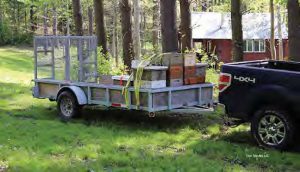 On a late Winter, cold morning, I loaded six colonies of bees on an open trailer and hauled them 50 miles to a state bee meeting. The ambient temperature was below freezing. Upon arrival at the meeting, I discovered that I caused the confined colonies to overheat and suffocate. They were all dead. Egad, it was below freezing. Driving to the meeting that day, my concern was that the outer covers should not blow off. I had no idea that I was worrying about the wrong thing. At another property, at another time, yet another neighbor came over and saw two colonies I had there. He said, “Oh, I didn’t know you had bees back here.” He and I were standing in the colonies’ flight path and I worried that he would be stung. Even as I was having that very thought, a bee needlessly stung him just under his right eye. I can only write that I was aghast. I was right to worry. I should have worried more. I should have responded to my worry. Worrying is not a bad thing.
On a late Winter, cold morning, I loaded six colonies of bees on an open trailer and hauled them 50 miles to a state bee meeting. The ambient temperature was below freezing. Upon arrival at the meeting, I discovered that I caused the confined colonies to overheat and suffocate. They were all dead. Egad, it was below freezing. Driving to the meeting that day, my concern was that the outer covers should not blow off. I had no idea that I was worrying about the wrong thing. At another property, at another time, yet another neighbor came over and saw two colonies I had there. He said, “Oh, I didn’t know you had bees back here.” He and I were standing in the colonies’ flight path and I worried that he would be stung. Even as I was having that very thought, a bee needlessly stung him just under his right eye. I can only write that I was aghast. I was right to worry. I should have worried more. I should have responded to my worry. Worrying is not a bad thing.
When is the best time to worry?
I seem to do my best worrying about 11:00 PM. The day is done. I am quieted and I have time to think. Is the cluster covering those queen cages? Did I leave enough honey frames in those new colonies? Will they swarm tomorrow? Did that last mite treatment work? Did I release the queens too soon? Do I have too many colonies in my home yard? But readers, I ask, are you and I truly worrying or are we just reviewing our management decisions? Like so many other things in life, bee colony management is not an exact procedure. We do our best. We strive to always win more than we lose. Just ask your computer thesaurus for alternatives to “worry”. Stunning number of choices. Is “worry” always the best term for what we are feeling? Maybe we are just second guessing.
It’s okay:
Go ahead. Worry about your bees. Second guess your decisions. It’s how we grow in our craft. It’s how we help others grow. Fretting helps us stay on the management path when the way is unclear.
Thank you:
If you wrote me and I did not respond, please know that I am sorry and I truly appreciate you taking time to write. It was not because I did not care. If you subscribed to my YouTube channel and I did not tell you I appreciated your decision, I apologize. I meant to, but I just did not get to it. If we are friends on Facebook and I have not responded to your message, it was never a personal affront. If you have listened to some of Kim Flottum and my podcasts, I thank you for that. We need listeners. If you read this article, I especially thank you. I appreciate the privilege of being able to work beyond my retirement. Without an audience, I have no reason. Thank you.
Dr. James E. Tew, Emeritus Faculty, Entomology, The Ohio State University and, One Tew Bee, LLC; [email protected]; http://www.onetew.com
